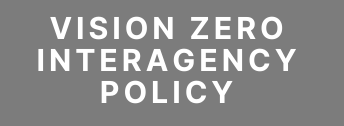 |
|||

|

|

|

|

|

|

|
 |
Vision Zero Interagency Policy
STATE-WIDE POLICY AND INTERAGENCY APPROACH
This policy is developed in accordance with Section 2(e) of Connecticut Public Act 21-28, AN ACT CONCERNING PEDESTRIAN SAFETY, THE VISION ZERO COUNCIL, SPEED LIMITS IN MUNICIPALITIES, FINES AND CHARGES FOR CERTAIN VIOLATIONS AND THE GREENWAYS COMMEMORATIVE ACCOUNT, of the Connecticut General Statutes (CGS 13b-23b). It is the policy of the Vision Zero Council to develop an interagency approach to eliminate all transportation-related fatalities and severe injuries to pedestrians, bicyclists, transit users, motorists and passengers. The council shall consider ways to improve safety across all modes of transportation by using data, building new partnerships, implementing safe planning and community-based solutions to achieve the goal of zero transportation-related fatalities. The following policy will be adopted by all agencies who sit on the council.
Objectives:
Public, High-Level, and Ongoing Commitment
High-level leadership and sustained political commitment are essential to Vision Zero success. Participating agency commissioners or their designees and other key elected officials must set the tone and direction for Vision Zero and back up their words of commitment with action, reflected in data-driven and equitable spending decisions, effective policies, and evidence-based practices that prioritize safety (even when this means a shift from the status quo). Following from this, the leaders of the public health, police, and transportation agencies should be closely involved with the day-to-day work of Vision Zero and ensure consistent interagency coordination.
Authentic Engagement
Meaningful and accessible community engagement toward Vision Zero strategy and implementation is employed, with a focus on equity
• Engage the community in meaningful, culturally relevant ways and support involvement by influential community leaders
• Prioritize support of communities most impacted by traffic crashes and most traditionally underserved by safety efforts and equitable infrastructure planning decisions
Strategic Planning
A Vision Zero Action Plan is developed, approved, and used to guide work. The Plan includes explicit Specific, Measurable, Achievable, Relevant, and Time-bound (SMART) goals, and it identifies responsible stakeholders
• The Action Plan and corresponding strategies are built on the Safe Systems approach by designing and maintaining a transportation system where human error does not result in loss of life or severe injury or disability
• Leadership across these agencies consistently prioritizes safety via a collaborative working group and other resource-sharing efforts
Equity-Focused Analysis and Programs
-
Commitment is made to an equitable approach and outcomes, including prioritizing engagement and investments in traditionally under-served communities and continuing to practice equitable traffic enforcement.
-
Any enforcement efforts within Vision Zero will be focused on traffic violations that pose a danger on our roadways as identified by quality data analysis to prevent any disproportionate enforcement levels by race, ethnicity, disability, and socioeconomic status.
Procedures:
Political Commitment
The commissioners of the state agencies that make up the Vision Zero Council commit to shared goals and objectives toward a Vision Zero goal to achieve zero traffic fatalities, serious injuries, and disability among all road users (including people walking, biking, using transit, and driving) within a set timeframe. This should include passage of a local policy laying out goals, timeline, stakeholders, and a commitment to community engagement, transparency, and equitable outcomes. Leadership across these agencies consistently engages in prioritizing safety via a collaborative working group and other resource sharing efforts.
Equity
Vision Zero Council members, and stakeholders commit to an equitable approach to Vision Zero by establishing inclusive and representative processes and equitable outcomes by ensuring measurable benchmarks to provide safe transportation options for all road users.
Development of an Action Plan
A Vision Zero Action Plan (or Strategy) will be created following the acceptance of the Vision Zero Interagency Policy. The Action Plan is implemented with clear strategies, “owners” of each strategy, interim targets, timelines, and performance measures.
Cooperation and Collaboration
A commitment is made to encourage meaningful cooperation and collaboration among relevant governmental agencies and community stakeholders to establish a framework for multiple stakeholders to set shared goals and focus on coordination and accountability.
Safe Systems Approach
Vision Zero Council members commit to and prioritize a safe systems-based approach to Vision Zero — focusing on the built environment, systems, and policies that influence behavior — as well as adopting messaging that emphasizes that these traffic losses, injuries, and disabilities are preventable.
Data Driven Analysis
Vision Zero Council members commit to gather, analyze, utilize, and share reliable data to understand traffic safety issues and prioritize resources based on evidence of the greatest needs and impact.
Transparency
The Vision Zero Council’s processes are transparent. Safety stakeholders and the larger safety community work together to provide regular updates on the progress of the Action Plan and performance measures and submit a yearly report.

